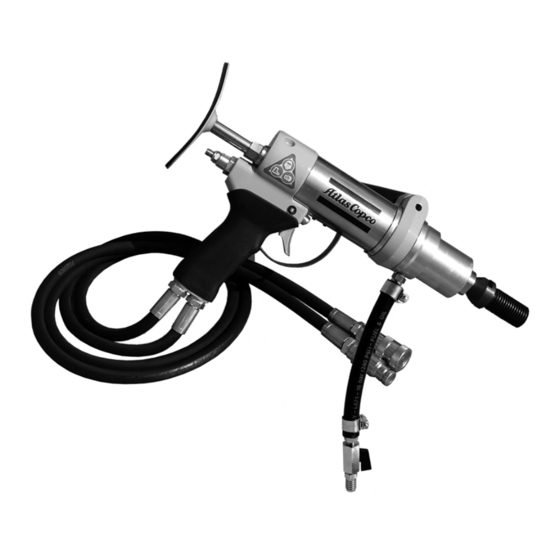Atlas Copco LCD 1500 Sicherheits- und Betriebsanleitung - Seite 7
Blättern Sie online oder laden Sie pdf Sicherheits- und Betriebsanleitung für Bohrer Atlas Copco LCD 1500 herunter. Atlas Copco LCD 1500 20 Seiten. Hydraulic core drill

LCD 500, 1500
WARNING Unexpected movements
The inserted tool is exposed to heavy strains when
the machine is used. The inserted tool may break
due to fatigue after a certain amount of use. If the
inserted tool breaks or gets stuck, there may be
sudden and unexpected movement that can cause
injuries. Furthermore, losing your balance or slipping
may cause injury.
Make sure that you always keep a stable position
►
with your feet as far apart as your shoulder width,
and keeping a balanced body weight.
Always inspect the equipment prior to use. Never
►
use the equipment if you suspect that it is
damaged.
Make sure that the handles are clean and free of
►
grease and oil.
►
Keep your feet away from the inserted tool.
Stand firmly and always hold on to the machine
►
with both hands.
Never drill in an old hole.
►
►
Never start the machine when it is lying on the
ground.
Never 'ride' on the machine with one leg over the
►
handle.
Never strike or abuse the equipment.
►
►
Check regularly for wear on the insertion tool, and
check whether there are any signs of damage or
visible cracks.
Pay attention and look at what you are doing.
►
WARNING Stalling hazard
If the insertion tool gets caught during operation, the
whole machine will start to rotate if you lose your grip
on it. This unexpected rotation of the entire machine
may cause serious injury or death.
►
Stand firmly and always hold onto the machine
with both hands.
Make sure that the handle or handles are clean
►
and free from grease and oil.
Never drill in an old hole.
►
WARNING Trapping hazard
There is risk of neck ware, hair, gloves and clothes
getting dragged into or caught by a rotating insertion
tool or accessories. This may cause choking,
scalping, lacerations or death. To reduce the risk:
►
Never grab or touch a rotating drill steel.
Avoid wearing clothing, neck ware or gloves that
►
may get caught.
►
Cover long hair with a hair net.
© 2015 Construction Tools EOOD | No. 3392 5189 01c | 2015-01-31
Original instructions
Safety and operating instructions
WARNING Dust and fume hazard
Dusts and/or fumes generated or dispersed when
using the machine may cause serious and permanent
respiratory disease, illness, or other bodily injury (for
example, silicosis or other irreversible lung disease
that can be fatal, cancer, birth defects, and/or skin
inflammation).
Some dusts and fumes created by drilling, breaking,
hammering, sawing, grinding and other construction
activities contain substances known to the State of
California and other authorities to cause respiratory
disease, cancer, birth defects, or other reproductive
harm. Some examples of such substances are:
Crystalline silica, cement, and other masonry
●
products.
●
Arsenic and chromium from chemically-treated
rubber.
Lead from lead-based paints.
●
Dust and fumes in the air can be invisible to the
naked eye, so do not rely on eye sight to determine
if there is dust or fumes in the air.
To reduce the risk of exposure to dust and fumes,
do all of the following:
►
Perform site-specific risk assessment. The risk
assessment should include dust and fumes
created by the use of the machine and the
potential for disturbing existing dust.
►
Use proper engineering controls to minimize the
amount of dust and fumes in the air and to
minimize build-up on equipment, surfaces,
clothing, and body parts. Examples of controls
include: exhaust ventilation and dust collection
systems, water sprays, and wet drilling. Control
dusts and fumes at the source where possible.
Make sure that controls are properly installed,
maintained and correctly used.
►
Wear, maintain and correctly use respiratory
protection as instructed by your employer and as
required by occupational health and safety
regulations. The respiratory protection must be
effective for the type of substance at issue (and if
applicable, approved by relevant governmental
authority).
►
Work in a well ventilated area.
If the machine has an exhaust, direct the exhaust
►
so as to reduce disturbance of dust in a dust filled
environment.
Operate and maintain the machine as
►
recommended in the operating and safety
instructions
7
